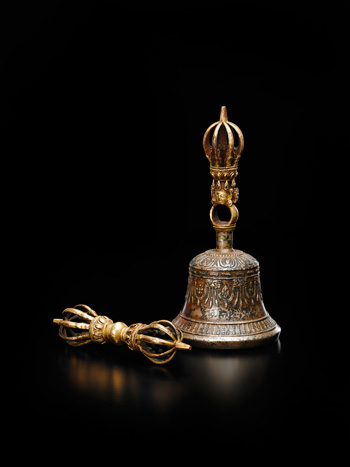The Ghanta and Vajra are indispensible hand held ritualistic instruments according to Tibetan Buddhism. While the vajra is symbolic of the male attribute of skillful means, the Ghanta represents the feminine attribute of wisdom and supreme knowledge. Taken together, it is connotative of the union of the aforementioned attributes, which ultimately leads to enlightenment and liberation. In retrospect, the third emperor of the Ming dynasty, the Yongle emperor was a fervent Buddhist, Tibetans lamas and the heads of various sects were invited to visit China to instruct him on Tibetan Buddhism. These guests were gifted with titles and ritual objects. The high regard of the recipient for receiving ritualistic objects was confirmed again almost two hundred years later, when the Qianlong emperor received a Ghanta and Vajra set from the Seventh Dalai Lama for his seventieth birthday. Compare with a very similar pair of a ritual Ghanta and Vajra dated to the Ming dynasty, illustrated in The Museum of art in San Francisco, United States, 1994, p.42.
|
8016
A SET OF GILT BRONZE RITUAL GHANTA AND VAJRA
MING DYNASTY |
|
The gilt bronze Vajra with eight prongs on either side frieze with lotus petals with a baluster form handle in the center, the Ghanta with gilt handle cast with a figure with its feature finely incised, wearing a eight prongs domed-shaped crown encircled with a band of teardrop panels rendered in openwork, the bell body cast in relief with a frieze of ferocious masks suspending pendent beaded jewel strands, set in between a band of lappet and a band of vajra motifs. |
|
Estimate
300,000 - 480,000 1,172,000 - 1,875,000 38,700 - 61,900
|
|
|
The Ghanta and Vajra are indispensible hand held ritualistic instruments according to Tibetan Buddhism. While the vajra is symbolic of the male attribute of skillful means, the Ghanta represents the feminine attribute of wisdom and supreme knowledge. Taken together, it is connotative of the union of the aforementioned attributes, which ultimately leads to enlightenment and liberation. In retrospect, the third emperor of the Ming dynasty, the Yongle emperor was a fervent Buddhist, Tibetans lamas and the heads of various sects were invited to visit China to instruct him on Tibetan Buddhism. These guests were gifted with titles and ritual objects. The high regard of the recipient for receiving ritualistic objects was confirmed again almost two hundred years later, when the Qianlong emperor received a Ghanta and Vajra set from the Seventh Dalai Lama for his seventieth birthday. Compare with a very similar pair of a ritual Ghanta and Vajra dated to the Ming dynasty, illustrated in The Museum of art in San Francisco, United States, 1994, p.42.
